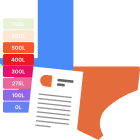Transform Your Teaching
with AI-Powered Worksheets
With ReadTheory’s Instant Worksheet Builder, you can create engaging, grade-appropriate worksheets tailored to your students in minutes. Spark curiosity, save time, and empower critical thinking with AI-powered tools designed for teachers like you.


The Lunar Leap: Humanity's Giant Jump
The Apollo 11 mission, in the heat of the Cold War space race, emerged as America's triumphant answer to the world. On July 20, 1969, Neil Armstrong, Buzz Aldrin, and Michael Collins embarked on a historic voyage that led them 238,855 miles away from earth, to the moon. This mission was a manifestation of technological prowess, powered by the Saturn V rocket, the most powerful vehicle ever made. It was a testament to human ambition and a symbol of a new age of exploration, transforming Armstrong and Aldrin into household names. Though celebrated, the moon landing hasn't been without controversy, with conspiracy theories suggesting it was all a hoax. Yet, the overwhelming evidence, from rock samples to high-resolution photos, confirms the authenticity of this monumental event. With the promise of a new age of lunar exploration on the horizon, the moon landing continues to inspire as we set our sights even deeper into the cosmos.
Question 1
Who were the astronauts on the Apollo 11 mission?
Neil Armstrong, Buzz Aldrin, and Michael Collins
Neil Armstrong, Buzz Aldrin, and John Glenn
Edwin Aldrin, Michael Collins, and Yuri Gagarin
Buzz Aldrin, Michael Collins, and James Lovell
Neil Armstrong, Michael Collins, and Pete Conrad
Question 2
What is the meaning of 'manifestation' in the context of the Apollo 11 mission?
A public display
A secret mission
A failed attempt
An imagined event
A hidden symbol
Question 3
What powered the Apollo 11 mission?
The Saturn V rocket
The Apollo Lunar Module
The Orion spacecraft
The Space Shuttle
The Mars Rover
Question 4
What does the moon landing symbolize?
A new age of exploration
The end of the space race
America's defeat in the Cold War
The limitations of human ambition
The failure of technology
Question 5
What evidence confirms the authenticity of the moon landing?
Rock samples and high-resolution photos
Live television broadcast
Witness testimonies
Government documents
All of the above
 or share via
or share via

Assign the ReadTheory pretest to determine students' reading levels.

Why Teachers Love
Instant Worksheet Builder?

Tailored Content for Every Student
Craft worksheets with passages and multiple-choice questions customized to your chosen topic and grade level, ensuring relevance and engagement.

Save Hours
of Prep Time
Our AI, Lexi, generates complete worksheets—passages, questions, and answers—in minutes, freeing you to focus on teaching, not planning.

Standards-Aligned Learning
Every worksheet is designed to boost reading comprehension and critical thinking, aligning seamlessly with State Standards to help your students shine.
Personalized teaching
for personalized learning
Browse worksheets created and refined by educators using Lexi—your source for inspiration and ready-to-use resources.


ReadTheory is free for Teachers to use.
Join thousands of educators using ReadTheory for free. Sign up today and start creating in just minutes!





